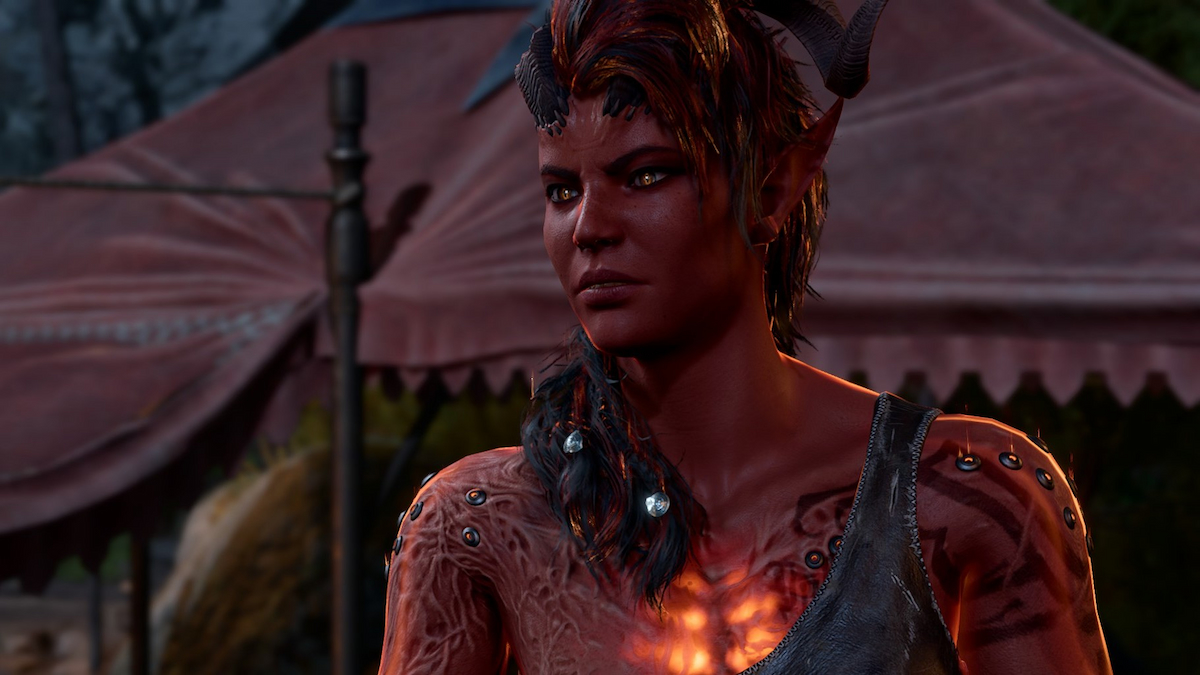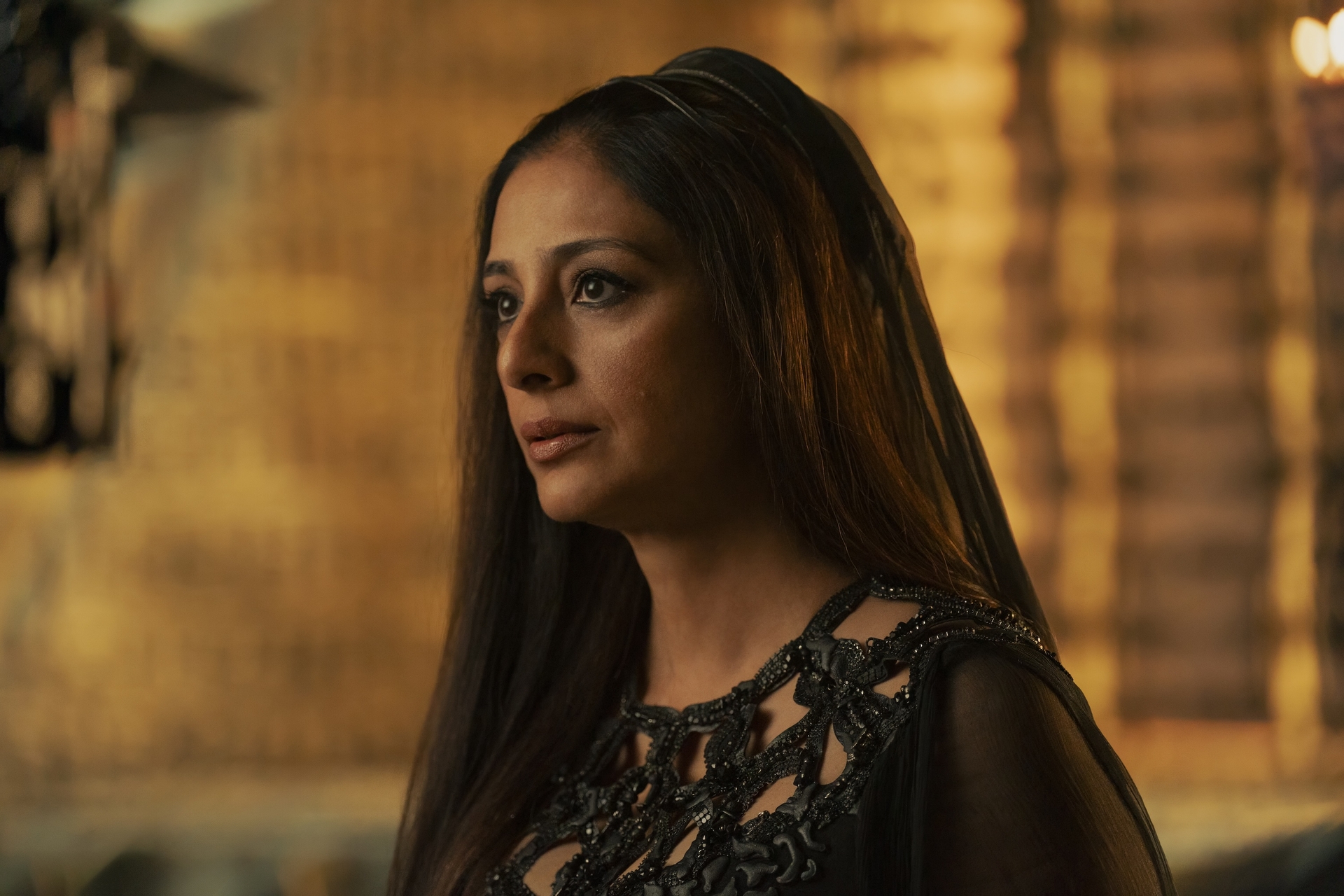Among the diverse and dynamic band of party members available to recruit in Baldur’s Gate 3, there’s one companion who players of all alignments just can’t help but love: Karlach, the fiery Tiefling barbarian with a heart of gold (or, more literally, infernal iron) whose unwavering compassion and jovial demeanor shine just as brightly as her ferocity on the battlefield. In this interview with Samantha Béart, who played the role of Karlach, Béart discusses bringing this cherished character to life — the processes, people, and inspirations that shaped Karlach’s identity.
During the time you spent working on Baldur’s Gate 3, what did your average day in the studio look like? Who were the people you collaborated with most often, and what were their jobs?
Sessions were usually four hours long, the vast majority of which were mocap. It was a rarity to have a voice-only session. I’d arrive at the studio, greet the team, suit up, step into the volume, calibrate the suit and the hands, then start recording. The team would be made up of a voice director, a performance director [referred to as a “movement director” later in this interview], a mocap engineer, and an audio engineer. The studio consisted of a large pool of these specialists. I’d like to congratulate them all on their part in Baldur’s Gate 3’s success — it was their artistry and their sheer hard work that delivered this whole world of living, breathing characters. I count myself extremely fortunate to have worked with such a generous and supportive team. It helped me give my absolute all.

How does Karlach compare to other video game roles you’ve done in the past, particularly Thomasina in The Excavation of Hob’s Barrow?
In my first game, as Sundren in Age of Wonders III, my lines were a series of monologues set either before or after campaigns, and the trick was finding the journey of each of these monologues. In that way, it was closer to the audio dramas I was recording at the time. With Thomasina and the branching narratives of point and click adventures, I wanted the sass and flaws of the characters in classics such as the Broken Sword and Gabriel Knight games. I needed to have an attitude towards absolutely everything and everyone in that world. Seeing as Thomasina was in almost every scene and I had the entire script at the start of recording, I could also see how other characters viewed her. That helped enormously in placing her arrogance and hubris. Whereas with Karlach, I didn’t have access to everyone else’s lines and therefore what they made of her, and I had to trust the directors and their years of experience on the project. I was eventually written for, so it became easier, as I was playing to my strengths and all my naughty habits became character traits… Oh, and mocap was a whole other new thing to add to the mix, but I’ll get to that in the next question.

This was your first time doing motion capture work, correct? What was the learning/training process like?
Correct, this was my first time and there was no training. There were so many actors involved in this game, and we were all in the same boat. It was challenging at first, but with time, remembering all the rules became muscle memory. Or the crew gave up on me. One of the two, anyway. In theatre, we work with movement directors all the time, so with my drama school training (where there were daily movement classes), it was a real comfort to have someone from that discipline on board — we spoke the same language. Discovering Karlach’s physicality was such a central part to finding her, and the quality of her movement had to take into account the technical requirements and limitations of mocap, like not covering markers, that I needed to stand on the same spot, etc. I relished the problem-solving parts of the process because that was the team at our most collaborative.
What aspects of this role did you find most challenging overall?
We frequently cite Sarah Connor or Ellen Ripley for this type of badass woman who’s seen shit you couldn’t imagine, but they lean into their respective traumas whereas Karlach runs as far away from hers as possible. I had to look to other places for inspiration. I found it in the gentle giants I’ve known throughout my life, in the late Ray Stevenson’s soulful bruiser Titus Pullo in HBO’s Rome, in the dark humour of people who’ve seen the horrors of war. I loved how unique Karlach was and how I hadn’t seen anyone like her portrayed in popular culture.
It’s been incredible to see the sheer amount of clips that players are sharing across the internet, but until you play a campaign with Karlach, it might not be apparent how profoundly traumatised she is. She’s living life to the fullest, she’s cracking jokes, she has no filter; she seems absolutely fine, right? The early days of recording were experimental at times: between player feedback, rewrites, and gauging how she fit in with the other origin companions, I could see that Karlach was broadening in a tonal sense, particularly with the lighter material, but her backstory never changed. She’s not happy for the sake of it, she’s behaving like that — overcompensating at times — to escape the reality of her predicament. She just wants to forget the last 10 years ever happened and go back to how it was. And as for anything beyond the immediate future? Absolutely not. She wants to pick up from where she left off 10 years ago, and so she’s emotionally stunted — particularly when it comes to relationships. We first discovered this in the infamous date scene (directed by Neil Newbon, our Astarion). With such a large role and with so many directors to work with, I saw it as my mission to ensure that each line was underpinned with the truth of her trauma. That sounds really dark, so another way to put it is that the reason everything’s so fun and fascinating to Karlach is because it’s literally not Hell.

Are there any scenes or lines of dialogue that were especially memorable/fun to record?
In terms of memorable, and following on from the last question: there’s a particular cinematic that occurs when Karlach exacts revenge on the person who sold her into slavery in Hell. It’s the most extraordinary scene set in the immediate aftermath, and it’s about what’s changed for her and what hasn’t. I’d been sitting on this timebomb of repressed trauma for what seemed like ages, and I finally got some catharsis; I finally got to let it all out. I only realised exactly how much pain she was in as we recorded; Karlach and I both stared into the abyss and sobbed our hearts out together. I can’t cry on cue; this was very real. I can’t thank writer Sarah Baylus enough for such a masterful and deeply truthful scene.
When it comes to lines, and in response to the question, “Was there really no one, the whole time you were in Avernus?” the answer, “Even I’m not desperate enough to fuck an imp.”
“Ah Mizora, I’ve taken more pleasant shits than you, and at least those can be buried after.” I’m beyond overjoyed that this line made the cut.
What traits do you and Karlach share? Did any of your own mannerisms or aspects of your personality influence the way Karlach was portrayed?
Although we’re a bit different physically, I carry myself with the confidence of a seven-foot-tall tavern brawler who’s been to the Hells and back. Personality-wise, we both share a dry sense of humour, we believe in practical solutions to life’s problems, personal integrity is more important than what other people think of us, and we are both triggered by injustice. I feel like I was able to get away with murder in terms of how much of myself I was allowed to bring to the role. No one stopped me…

Is there anything about Baldur’s Gate 3, or your performance specifically, that a general audience might not be aware of, but you wish they were (for example, any underappreciated behind-the-scenes work)?
Loads — ha! You have to come into the studio with strong ideas about where you want to go with a character but also be prepared to be steered in a completely different direction. Rather than recording chronologically, you record lines in order of priority. Changing a physical gesture can completely change the delivery of a line. All this is good, general actor advice, but I’m sharing it because so much of our process is invisible to players. Finally, it would be remiss to refer to the hundreds of actors in this game as “voice actors.” To do so erases the contribution of our performance directors, mocap engineers, animators, and so on. Because of NDAs, etc., I didn’t often get to see any visuals. It was the directors’ jobs to describe the world to me so I understood the context — it was kind of like being a DM. I knew it was going to be a big scene when they brought the crash mat out!
What sort of work do you hope to do in the future? Do you have any dream roles, video game genres you’re keen to try, etc.?
It’s taken me so long to get an opportunity like this, I’m just basking in all the love and acclaim that Karlach and the game in general are getting right now. This is the dream role. As for the future, I don’t really think in terms of genre, but instead of the role itself. I do like to live with a character for a while — to let my subconscious do a lot of work for me like it does with a character in a play, so another big role would be lush, but they’d have to be very different from what I’ve just done. I don’t care what genre or even format this is delivered in, I just want to play characters that move people.

In addition to the games mentioned above (Baldur’s Gate 3, The Excavation of Hob’s Barrow, and Age of Wonders III), Samantha has acting credits in Demon’s Souls (2020), The Great Ace Attorney Chronicles, The Solitaire Conspiracy, and others. They will also voice Alisa in Cabernet, a game in development by Party for Introverts. Earlier this year, Samantha was long listed for a BAFTA Games Award in the category of Performer in a Leading Role for her performance as Thomasina Bateman in The Excavation of Hob’s Barrow. In 2020, Samantha founded “Game Voices Connect,” an online conference for game audio professionals and the actors they work with.






Published: Aug 25, 2023 11:00 am